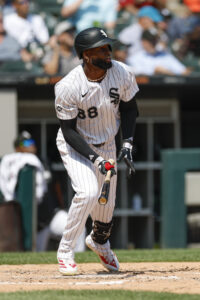The White Sox are bringing Luis Robert Jr. back into the fold for 2026. Jesse Rogers of ESPN reports that the team is exercising its club option over the center fielder. Robert will make $20MM in 2026, rather being paid a $2MM buyout and heading into free agency. The White Sox hold an additional $20MM club option over him for the 2027 season.
This was always the expected course of action once the White Sox opted not to trade Robert at the trade deadline. General manager Chris Getz has only reinforced that thinking in the months since, stating on multiple occasions that he expects the oft-injured center fielder to be a part of his club moving forward.
Two years ago, when the South Siders were in the earlier stages of their rebuild, Robert seemed like a potential big-ticket trade chip. His 2023 campaign was excellent. Robert made the All-Star team, garnered down-the-ballot MVP votes and won a Silver Slugger after raking at a .264/.315/.542 clip with 38 home runs. He also swiped 20 bags in 24 tries and played plus defense in center field.
At that point, the Sox had two guaranteed years remaining on Robert’s $50MM extension, plus a pair of club options. They didn’t deem any offers that offseason sufficient, and Robert was retained heading into the 2024 campaign. The next two years proved to be something of a worst-case scenario. Robert slashed a combined .223/.288/.372 in 856 plate appearances over the past two seasons and endured multiple trips to the injured list, missing time with a hip flexor strain and a pair of hamstring strains.
The hope heading into 2025 was that a healthier season would build trade value for Robert ahead of the deadline. He had perhaps the worst stretch of his career for the season’s first two-plus months but caught fire in early June. That sparked some trade interest, but not to the point that interested teams were willing to part with top-tier prospect talent. The Sox, not wanting to sell low on a player with All-Star, borderline MVP upside, held onto Robert. He posted middling offensive numbers in August before a hamstring strain late in the month ended his season.
Bleak as Robert’s overall season numbers were, he did post a solid .274/.335/.458 batting line (118 wRC+) with nine home runs, a 19.7% strikeout rate and a 7.6% walk rate in his final 198 trips to the plate. That’s a ways off his 2023 peak, but if Robert could manage that level of performance moving forward, he’d be a fine value at his $20MM price tag. Of course, that’s a colossal “if,” given both his frequent trips to the injured list and the awful 658 plate appearances he logged from Opening Day 2024 through early June 2025.
Robert’s name could well come back up in offseason trade chatter, but it’s hard to imagine the Sox moving him after hanging onto him at the deadline. Offers in July apparently weren’t appealing enough to make a move, and Robert’s .256/.287/.409 post-deadline production and subsequent season-ending hamstring strain didn’t do anything to boost his value.
Assuming Robert indeed heads to spring training as the center fielder for the ChiSox, he currently projects to be flanked by veterans Andrew Benintendi and Mike Tauchman. The Sox would love to find a way to move on from the final two years of Benintendi’s ill-fated five-year, $75MM contract, but that’s not likely unless they simply release him. Tauchman, like Robert, wasn’t moved at the deadline — but he’s a 34-year-old veteran coming off a solid enough season that an offseason trade is possible.
If Robert can turn in a big first half next year, it’s feasible that he could still command a notable trade return. There will always be injury concerns, but few center fielders possess such a dynamic set of raw tools. Center field upgrades are in short supply at any point of the calendar, and a $20MM price tag on both his 2026 season and 2027 option will look plenty reasonable if he’s healthy and productive next summer. There are a lot of ifs, and it’s certainly a risk to pick up his option, but the White Sox have virtually no money on the books and can afford to once again roll the dice on him bouncing back, even if it’s arguable that they should’ve taken the best return available in July and moved on entirely.


